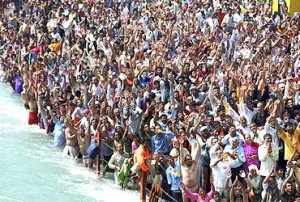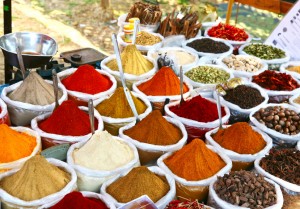 Population of India 2014
Population of India 2014
Based on the total number of births, total number of deaths, net migration rates, and the population of 2013, the current population of the Republic of India is estimated to be about 1,261,527,930 making it the second-most populous country in the world behind China. It contains about 130 million less people than China currently. India’s population makes up about 17.5% of the world’s population. The current estimated population indicates an increase of 9,388,334 people or a population growth rate of 0.75% from 2013. Based on the total land area of the country and the estimated population for 2014, the population density of India in 2014 is about 383.7 people per square kilometer or 993.8 people per square mile.
Environmental Issues in India 2014
The major environmental issues in India are forest and agricultural degradation of land, resource depletion, loss of biodiversity, public health, loss of resilience, and livelihood security for the poor. These issues are mainly attributed to the economic development throughout the country. Because the society and country is not highly developed economically, it does not have the resources and capabilities to sufficiently rid the country of pollution. Another cause of the environmental issues is the high population growth that occurs annually. The more people there are in the country, the more crowded the country becomes, and the more resources that are used. Air and water pollution are two major environmental issues that have serious effects on the country and the population. Frequent burning of fuelwood and biomass causes much of the air pollution. Lastly, the untreated sewage systems are the main causes of the water pollution.
Government in India 2014
India’s political system is considered to be a federation with a parliamentary system. The main legal document of the country is the Constitution of India. It is a constitutional republic and a representative democracy. The government is broken up into three branches: executive, legislative, and judicial. The Executive Branch is made up of the President, Vice-President, and the Council of Ministers. An electoral college elects the President; the President appoints the Prime Minister, who is a part of the Council of Ministers; and the Council of Ministers is made up of members of the legislature. The Executive Branch is considered to be subordinate to the Legislative Branch. The Legislative Branch is a bicameral parliament, consisting of the upper house, Rajya Sabha (Council of States), and the lower house, Lok Sabha (House of the People). The Rajya Sabha is elected by the state legislatures and they each serve six-year terms. The people directly elect the Lok Sabha and each member serves five-year terms. Lastly, the Judicial Branch is made up of three levels of courts: Supreme Court, High Courts, and trial courts. The Chief Justice of India presides over the Supreme Court, which is considered the ultimate interpreter of the constitution. The Supreme Court tends to take the cases that involve the rights of citizens.
Economy of India 2014
India is considered to have one of the largest economies by market exchange rates, as it is worth around $1.758 trillion according to the International Monetary Fund. However, because of the large population of the country, India is considered to be one of the poorest countries in the world since the nominal Gross Domestic Product per capita and the Gross Domestic Product per capita at Purchasing Power Parity are so low. But, it does have the second largest work force in the world of around 487 million workers. The economic system of India is constitutionally defined as socialist, but has been moving towards a free, capitalist society. The service sector is the largest economic sector in India, followed by the industrial sector. Some of the major industries in India include textiles, telecommunications, and chemicals. Some of the major exports include petroleum products, textiles, and jewelry.
Transportation in India 2014
India has one of the largest rail systems in the entire world, along with the most heavily used system in the world. The country has around 39,000 miles worth of railways, ranging from single-track lines to broad-gauge standard lines. Along with the rail system, the road system throughout India has exponentially grown over the last century. India has a bout 950,000 miles worth of roads throughout the regions. Despite this, though, there are some areas and villages where roads do not really come, making bus stops a couple of hours away. Lastly, there are two major Indian airlines that have international flights: Air India and Indian Airlines. The government owns all of the railway systems and airlines.
Health Care in India 2014
India has a universal health care system run by the individual states and territories. The Constitution challenges and demands that each state has an obligation to ensuring the nutrition and health of its constituents. Despite the existence of the universal health care system, there exists a private health care system as well. In fact, 70% of those in urban areas and 63% of those in rural areas use the private health care sector due to the poor quality of the public system and the locations of the public systems. Some major health issues in India include malnutrition, which has led to a high level of infant mortality, a moderate outbreak of Hepatitis B, poor sanitation, and a lack of safe drinking water in the slums of India. In order to combat many of the health issues in the country, the National Rural Health Mission was founded in 2005 in order to help establish effective and quality health care in the rural areas of the country.
India Population 2014 to 2028 Growth Projections
 Cuisine in India 2014
Cuisine in India 2014
Due to the large variety of geography in India, the food throughout the country varies based on the location due to the variety in soils and crops grown in the regions. Also, the variety of religions throughout the country also plays a role in the variety of food selection. Specifically, Dharmic beliefs have affected the cuisine in India, including a growing trend of vegetarianism. Many of the foods that are popular in India had been brought to the country during foreign rule or invasions, such as the potato and chilies. Some important ingredients in Indian cuisine are rice, many different types of lentils, a variety of oils, including vegetable, coconut, and peanut oil, chili peppers, cumin, ginger, and curry leaves.
In terms of eating habits, eating a healthy breakfast to start the day is important. Lunch tends to be fairly simple, mainly consisting of some form of rice or whole-wheat dish. The main meal of the day is considered to be dinner. While eating, people eat on the floor or on cushions quite low to the ground. Traditionally, food is eaten with the right hand, instead of using any utensils. Food is served with the left hand if a host or waiter does not serve it.


